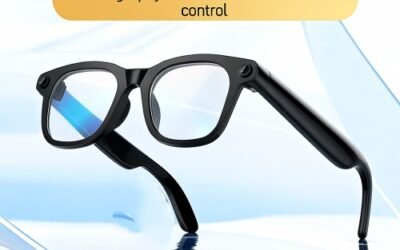How AI eyewear is transforming industries—and why OEM partners like ZhuoHao Technology are essential to scaling the revolution
The Future of Interaction Is Here – On Your Face
Imagine looking at a license plate and instantly identifying a vehicle’s registration details. Or walking through a museum and hearing the story behind each exhibit—without lifting a phone. Or paying for coffee with just a voice command.
This is no longer science fiction. As Wang Ruichao, deputy chief of the Lingyin Traffic Police Squadron in Hangzhou, shared, smart glasses like those from Lingban Tech now allow officers to identify vehicles in one second—dramatically improving traffic efficiency during peak hours.
At the 4th Global Digital Trade Expo, visitors experienced “look-up-and-interact” technology firsthand: using Rokid’s Leqi glasses to make payments, translate text, or identify objects—all without touching a phone.
From Niche to Mainstream: The Rise of AI Glasses
Smart glasses are having a breakthrough moment. After years of hovering at the edges of the consumer tech world, they’re now positioned to become the next major intelligent terminal.
Key drivers behind this shift:
- AI + AR Integration: Combining AI’s understanding with AR’s interactive display enables seamless, multi-sensory information flow.
- Lightweight Design: Rokid’s Leqi glasses weigh just 49 grams—comparable to regular eyewear—with chips, cameras, and batteries fully integrated into the frame.
- Dropping Costs: Mature supply chains and improved production processes are making smart glasses more affordable.
According to industry forecasts, global smart glasses shipments will reach 12.8 million units in 2025 (40% from China), with the market value exceeding ¥50 billion. By 2030, this could grow to ¥534 billion.
Real-World Impact: Beyond Consumer Tech
Smart glasses are proving transformative across sectors:
🚓 Public Safety
Hangzhou traffic police use Lingban glasses to identify vehicles in real-time, replacing manual checks that took 3–5 seconds with instant recognition.
✈️ Aviation & Industry
At Hangzhou Changlong aircraft hangar, engineers wearing AR glasses follow 3D dynamic disassembly guides with AI voice prompts—cutting training time from 3–5 years to months.
🔧 Energy & Manufacturing
At a Shaanxi natural gas plant, workers using X-Craft AR helmets receive real-time equipment data and predictive risk analysis—reducing inspection costs by 25% and annual maintenance fees by 10%.
🏥 Healthcare Training
Medical students using Rokid Studio AR glasses with the X-Training platform practice surgeries in virtual environments with real-time feedback—accelerating skill development.
The Manufacturing Challenge: Inside the “Impossible Triangle”
As Lingban CEO Zhu Mingming explains, smart glasses face a fundamental trade-off between weight, computing power, and battery life—the industry’s “impossible triangle.”
Overcoming this requires:
- Advanced materials and custom components
- Extreme miniaturization
- High-integration manufacturing
This is where specialized OEM partners like ZhuoHao Technology become essential. As a leading smart glasses manufacturer and OEM/ODM provider, ZhuoHao enables brands to:
✅ Optimize space and weight without sacrificing performance
✅ Scale production while maintaining quality
✅ Integrate complex systems—audio, AI, power, and optics—into slim, wearable forms
Without experienced manufacturing partners, even the most innovative smart glasses concepts struggle to reach the market at scale.
The Road Ahead: Ecosystem and Standards
The smart glasses landscape is evolving rapidly:
- YodaOS, Lingban’s proprietary operating system, is tailored for AR glasses—optimizing voice control, spatial computing, and power management.
- Industry standards are emerging, with China’s TAIL lab launching an AI glasses certification program covering 60+ test items across audio, imaging, privacy, and battery life.
- Offline retail expansion is making smart glasses more accessible, with plans to place them in thousands of optical stores nationwide.
Will Smart Glasses Replace Smartphones?
Not entirely—but they will change how we use phones.
“It’s unlikely phones will disappear completely,” says Zhu Mingming, “but they may stay in bags or pockets as computing hubs, while glasses handle daily interactions.”
Xiang Wenjie of Lingban adds: “Soon, smart glasses will be available in most optical stores, becoming a normal part of the shopping experience.”
The Role of OEMs in the Smart Glasses Revolution
As the industry moves from early adoption to mass market, experienced manufacturers like ZhuoHao Technology provide the engineering expertise and production scale needed to:
- Turn advanced prototypes into reliable products
- Meet growing global demand
- Drive down costs while improving quality
For brands entering the smart glasses space, the right OEM partner isn’t just helpful—it’s essential.
Interested in developing your own AI glasses line? Partner with ZhuoHao Technology —the OEM/ODM specialist behind some of the industry’s most advanced smart eyewear.
#AIGlasses #SmartGlasses #OEM #ZhuoHaoTechnology #AI #AugmentedReality #WearableTech #TechInnovation




0 Comments